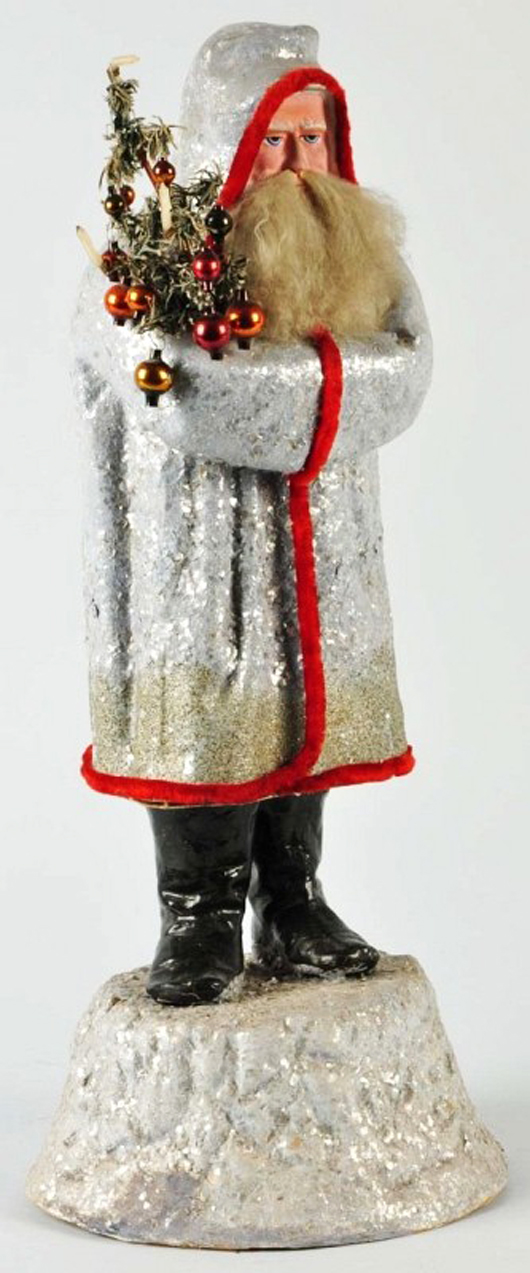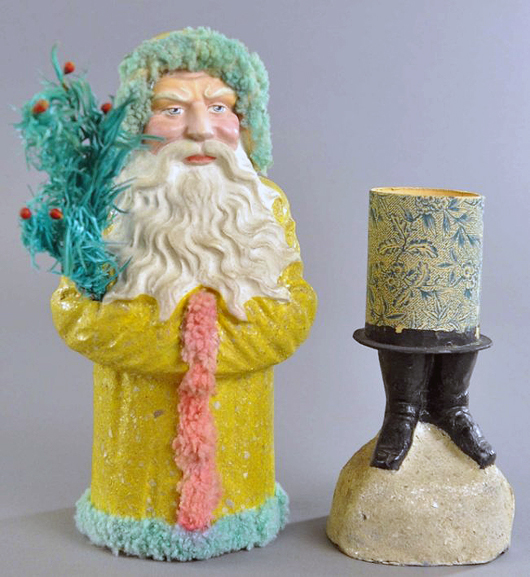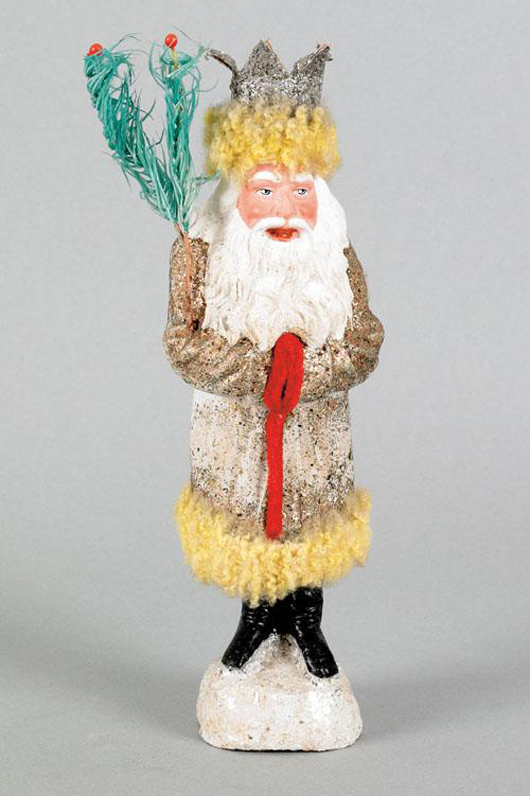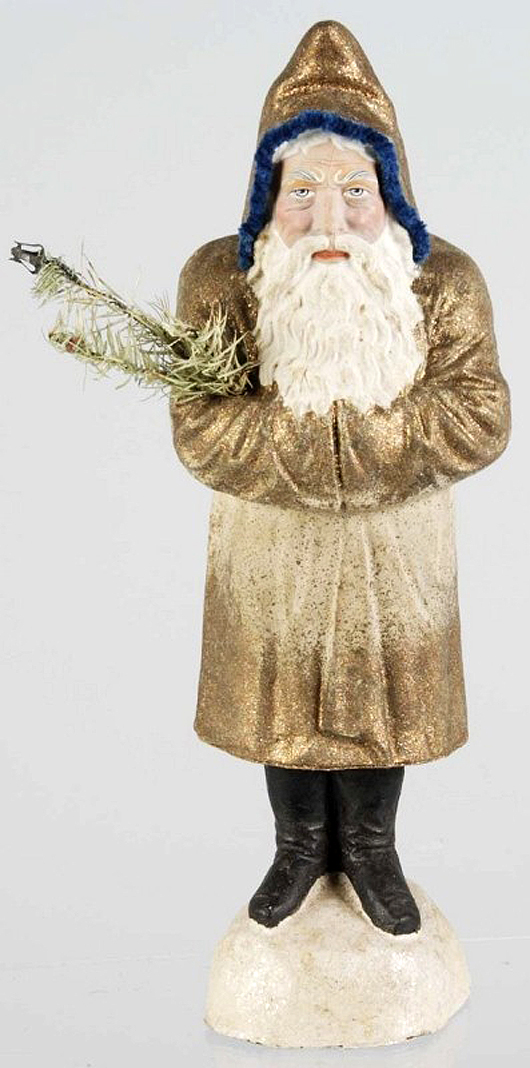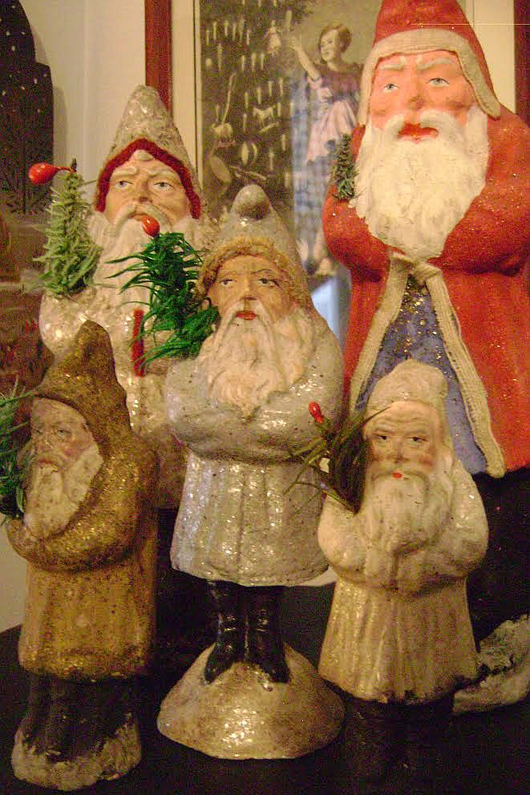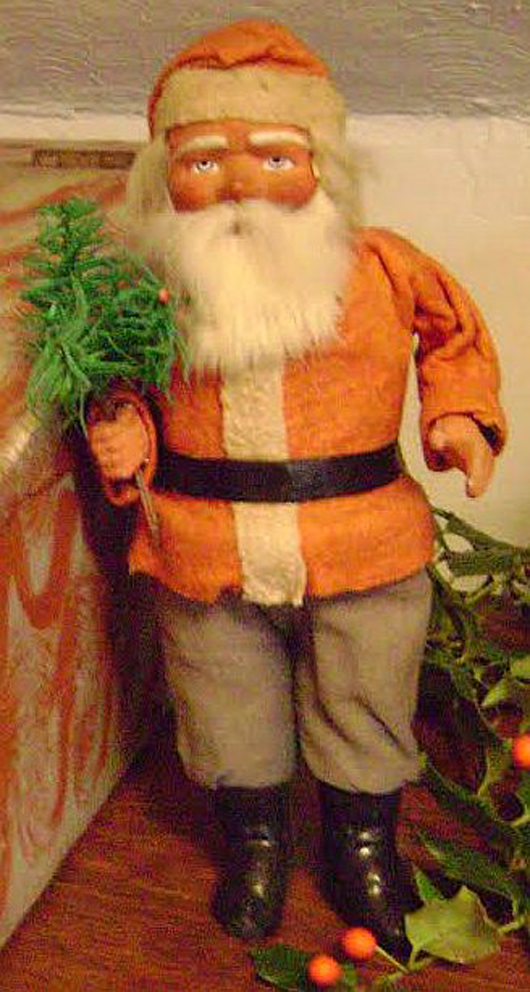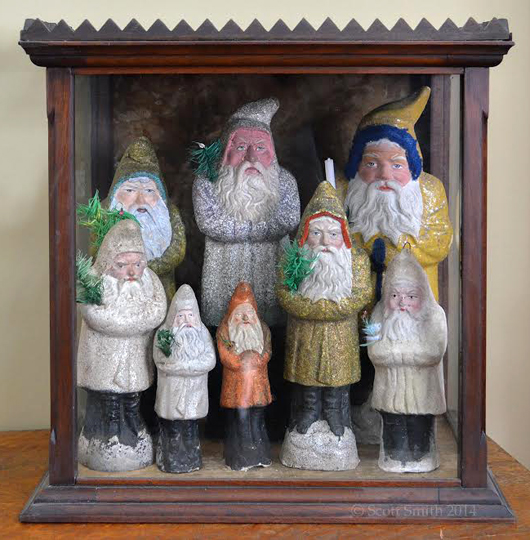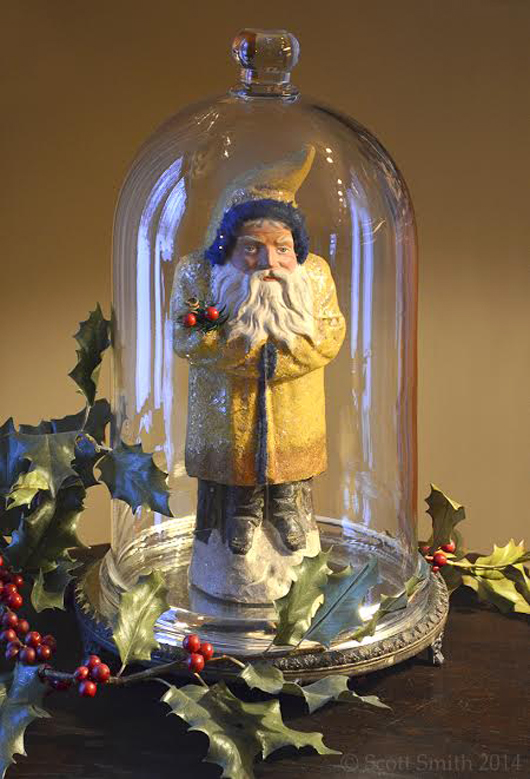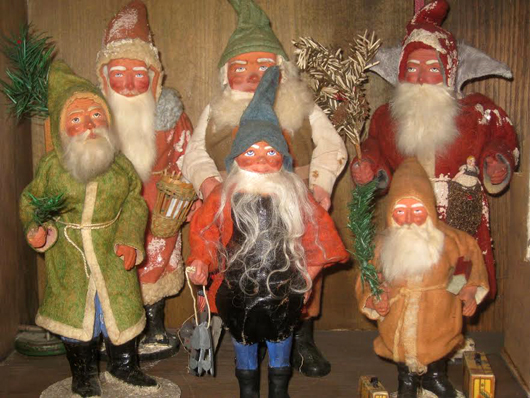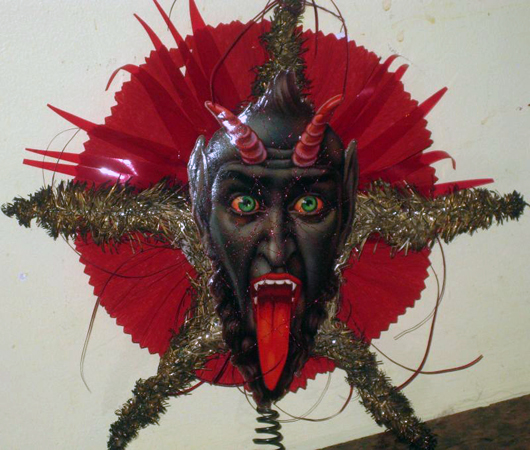
SAXONY, Germany – Twenty years ago, Lorraine Jones of Peabody, Mass.,, told her husband she thought she would be content if she bought just one Belsnickle candy container. Forty-nine Belsnickles later, Jones has collected a small troop of the fragile German papier-mâché candy containers that bring her year-round joy.
“I see a Belsnickle and get all excited. I live my life being a little child in my heart,” said Jones, trying to contain her laughter. “I guess I’m keeping that childhood excitement alive. My mother is gone, and she had such a love of Christmas. The Belsnickles keep that alive for me.”
Belsnickle is no Santa Claus. Although his true origins have vanished with the Christmas snow, he is the stern character who visited children a few weeks before Christmas to see who was naughty and who was nice. His thin, scowling presence, a sack of goodies in one hand and a bundle of whipping switches in the other, was enough to terrify the goodness into any child.
The German tradition dates back to a time when St. Nicholas and the Kristkind or Christ Child, represented as a blond angel dressed in white, made the rounds together. But after the Protestant Reformation in the 16th century, St. Nicholas was frowned upon. In order to fill the void, various regions devised their own character. In Hessen he became “Pelznickle,” which means “Nicholas in Fur.” In Schwäben it was “Pelzmärtle.” In Rheinland Falls they pronounced the “P” as a “B” and he became Belznickle.
The tradition spread as Germans emigrated to other countries. In Brazil Pelznickle flourished.
“The northern Germans brought Belsnickle with them when they moved to Pennsylvania.” explained Jones. Indeed the Pennsylvania Dutch (which comes from Deutsch, i.e. Germans), still have the tradition of Belsnickle.
Around 1870 papier-mâché composition Belsnickles began to be made in Sonneberg, Thuringia, Germany, for export. The crafting of Belsnickles there was fitting, as the area was already renowned for their expressive and beautiful dolls.
A Belsnickle was formed in two plaster molds, front and back. Then the two halves were dried and joined together, finished and painted. Some were purely decorative; others were made into candy containers given to children at Christmastime.
The Belsnickles’ hands are usually tucked tight inside their coat sleeves, but sometimes they strike a more relaxed pose. Some of them look a little hunch-backed. They have arresting faces, with expressive eyebrows, looking stern but wise. It is the perfect expression for meting out punishment for naughty behavior. While children were probably scared of Belsnickle, his image on a candy container was loveable in an overbundled sort of way.
“With the candy containers, some separate at the legs – the boots slide off; and some separate at the waist,” notes Jones. “Inside there is a little paper tube. I think it was used for candy, cookies, nuts or little toys.”
Jones has been collecting these fragile Belsnickle candy containers for 20 years, scouring antique shops, auctions and even Ebay. During this time she has watched the price increase from a few hundred dollars to literally thousands for a large Belsnickle in very good condition. Of course, she never forgets her first one.
“I look at my first Belsnickle and he is not such a good one. Only about 5 inches high, and his tree is worn down to a wire, he has no color left, and his eyes are chipping away,” said Jones. But you can tell by the tone of her voice that she is like a mother describing a homely but well-loved child. He has earned a special place in her mirror-backed glass display cabinet. Artist Scott Smith of Rucus Studio in Michigan can sympathize. His Belsnickles hold a place of honor in a glass display case in his studio. He draws inspiration from their detailed faces.
“I collect all antique Christmas, but the candy containers appeal to me because they have a mix of concept and function – it’s a decorative figurine, but it also had another use,” said Smith. “I like the Belsnickles because they have that elf-like, woodland appeal. They can be cute and simple or elaborate and menacing.”
After working for years as a commercial artist and art director, Smith opened his own studio in 2000. Using a similar molding process, he sculpts his own whimsical characters – owls, moons, pumpkin-headed people – that look like they stepped from the pages of a story book.
“I try to use the same methods, but we don’t have the same materials and recipes they had,” noted Smith.
He related that the making of Belsnickles was truly a cottage industry. Whole families worked on the project, using their own hand-carved plaster molds and secret recipes for the papier-mâché or chalk “clay” that was pressed into them.
“Sometimes they had to make do with the materials they had,” noted Smith. “The Belsnickles could not mold or rot or be eaten by animals. Yet I’m sure they had no thought in their minds that these things would last for 100 years or more.”
It is remarkable that the candy containers survived not only their first opening by little fingers, but sometimes even being glued together to use as a Christmas decoration for generations to come.
The variety of Belsnickles is truly amazing. They can be found with hooded coats of many different hues, from red, to deep plum purple, pink, yellow, white, blue, green and even sometimes brown. Often their coats sparkle with mica glitter or are trimmed with real fur. They perch in their black boots on snow-covered mounds or in front of trees. Many carry feather trees or baskets of toys, sometimes with a tiny American flag, as virtually all were made for export.
“They were made with high-end craftsmanship, from very elaborate to cheap and affordable for the average consumer,” said Smith. “They made everything from a 2-3 inch (5-7cm) ornament, to 6-8 inch (15-20cm) candy container – that was the average size, to 14, 24, or 36 inch (35, 61, 92cm) larger ones for very wealthy families or for store displays to attract customers into a shop.”
World War I took its toll on the Belsnickle industry. Many of the plaster molds were destroyed; materials were scarce. Belsnickles made after this time period were more like cardboard, sometimes even stapled together at the sides. Japanese Belsnickles also appeared on the market, “But,” says Lorraine Jones referring to skin color, “They were pink, pink, pink!”
Belsnickle fell out of fashion. German children became more interested in the Weihnachtsmann, who brought their presents on Christmas Eve. In the U.S. Santa Claus was becoming a jollier, happier old elf, helped along by the illustrations of Thomas Nast in the early 1880s and the red-suited Coca Cola Santa of the 1930s. Even so, another more sinister form of “the punisher” persisted in Austria.
When Bill Steely of Westchester County, N.Y., attended his first Golden Glow of Christmas Past convention, the only family member willing to go with him was his then 6-year old daughter Chloe.
“At our first room hop we discovered Krampus, and said, ‘Woa! What does a devil have to do with Christmas?”
Some eastern Germans still know Belznickle as Knecht Ruprecht. But Austria clings to a hooved and horned creature called Krampus.
“Of all the bad personas, Krampus was quite severe,” explained Steely. “He would put you in his sack and take you to the depths of hell. So if your goal is to scare your children into being good, Krampus really meets that goal.”
Chloe is now 19, and the Steelys have a full range of Krampus collectibles. But they also have a soft spot for Belsnickle. After all, fair is fair.
Take a peek at these websites for more information: www.GoldenGlow.org; www.RucusStudio.com

ADDITIONAL IMAGES OF NOTE
